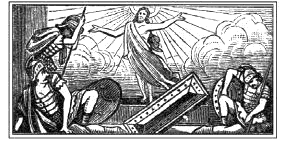
| Contents | Symbolum Nicaenum Nicene Creed |
Symbola |

The Symbolum Nicaenum, or Nicene Creed, has a complex history. It was first promulgated at the Council of Nicea (325), though in an abbreviated form from what we have below. St. Athanasius attributes its composition to the Papal Legate to the Council, Hossius of Cordova. The Creed is also sometimes called the Nicene-Constantinoplian Creed since it appears in the Acts of the Council of Constantinople (381), but it is clear that this Council is not the source of that composition for it appears in complete form in the Ancoratus of Epiphanius of Salamis some seven years earlier in 374. In any case, it was this text that appears in the Acts of the Council of Constantinople that was formally promulgated at Chalcedon in 451 and has come down to us as our present Nicene Creed. It was at the councils of Nicea and Constantinople that the true nature of Jesus was defended against two heresies that had sprung up. The Arians denied Christ's divinity and the Monophysites denied Christ's humanity. The councils, drawing upon the traditions handed down to them from the Apostles, condemned both heresies and declared that Jesus was indeed both true God and true man. In the 11th century this creed became part of the Mass. A partial indulgence is granted to the faithful who recite the Symbolum Nicaenum.
|
| CREDO in unum Deum, Patrem omnipotentem, factorem caeli et terrae, visibilium omnium et invisibilium. | I BELIEVE in one God, the Father almighty, maker of heaven and earth, of all things visible and invisible. |
| Et in unum Dominum Iesum Christum, Filium Dei unigenitum, et ex Patre natum ante omnia saecula. Deum de Deo, Lumen de Lumine, Deum verum de Deo vero, genitum non factum, consubstantialem Patri; per quem omnia facta sunt. | I believe in one Lord Jesus Christ, the Only Begotten Son of God, born of the Father before all ages. God from God, Light from Light, true God from true God, begotten, not made, consubstantial with the Father; through Him all things were made. |
| Qui propter nos homines et propter nostram salutem descendit de caelis. Et incarnatus est de Spiritu Sancto ex Maria Virgine, et homo factus est. | For us men and for our salvation He came down from heaven, and by the Holy Spirit was incarnate of the Virgin Mary, and became man. |
| Crucifixus etiam pro nobis sub Pontio Pilato, passus et sepultus est, et resurrexit tertia die, secundum Scripturas, et ascendit in caelum, sedet ad dexteram Patris. | For our sake He was crucified under Pontius Pilate, He suffered death and was buried, and rose again on the third day in accordance with the Scriptures. He ascended into heaven and is seated at the right hand of the Father. |
| Et iterum venturus est cum gloria, iudicare vivos et mortuos, cuius regni non erit finis. | He will come again in glory to judge the living and the dead and His kingdom will have no end. |
| Et in Spiritum Sanctum, Dominum et vivificantem, qui ex Patre Filioque procedit. | I believe in the Holy Spirit, the Lord, the giver of life, who proceeds from the Father and the Son, |
| Qui cum Patre et Filio simul adoratur et conglorificatur: qui locutus est per prophetas. | Who with the Father and the Son is adored and glorified, who has spoken through the Prophets. |
| Et unam, sanctam, catholicam et apostolicam Ecclesiam. | And I believe in one holy, catholic and apostolic Church. |
| Confiteor unum baptisma in remissionem peccatorum. Et expecto resurrectionem mortuorum, et vitam venturi saeculi. Amen. | I confess one Baptism for the forgiveness of sins and I look forward to the resurrection of the dead and the life of the world to come. Amen |
<- Prev |
Next-> |
